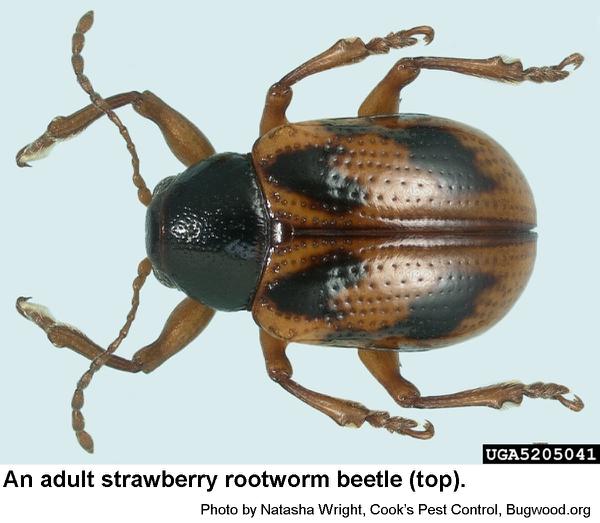Strawberry Rootworm on Ornamentals
The strawberry rootworm, Paria fragariae, is the grub of a small leaf beetle that usually feeds at night. In North Carolina, adult Paria leaf beetles are active from at least April through November. Adult strawberry rootworms are brown, shiny, oval-shaped beetles with four dark blotches on the top wings. These beetles are about 1/8 inch long. The slender, creamy white rootworms are slightly longer. Adult beetles overwinter in mulch or soil crevices and become active in April and May. At night, they eat small holes in leaves, and females lay eggs on older leaves near the soil surface. Larvae burrow into the ground to feed on strawberry roots during the summer. Mature rootworms pupate in the soil. New adults begin emerging in mid-summer, and these beetles feed on foliage through early fall.
Host Plants
We have had records of strawberry rootworm adults on azalea, sourwood, rhododendron, and, of course, strawberry. Strawberry rootworm adults chew small, oval or round holes into the upper leaf surface. Perhaps because of their small size, strawberry rootworms do negligible damage to the roots of plants.
Residential Recommendations
Strawberry rootworm adults feed primarily at night. To scout for them use a flashlight to examine plants after dark. Pyrethroid insecticides should give more than adequate control of Paria leaf beetle because when properly applied pyrethroids are effective for such leaf feeders, they have a long residual life on the plant, and they are relatively safe for humans and pets (except fish! Don't apply pyrethroids around ponds, pools, or streams.). Sevin should also give adequate control, but Sevin does not have as long a residual life so it may have to be reapplied for complete control. Pyrethroid and Sevin insecticides are available at most big box stores, nurseries, and garden centers.
References
- Strawberry Rootworm in Strawberry. Burrack, H. 2014. NC State Extension. NC State Extension Publications.
- Strawberry Rootworm. Mattoon, N., editor. 2017. New York Berry News Vol. 16 No. 2. 20 pp.
- Strawberry Rootworm, Paria fragariae. Anonymous. 2004. University of Illinois, College of Agricultural, Consumer and Environmental Sciences.
- Extension Plant Pathology Publications and Factsheets
- Horticultural Science Publications
- North Carolina Agricultural Chemicals Manual
For assistance with a specific problem, contact your local Cooperative Extension Center.
This Factsheet has not been peer reviewed.
Publication date: Aug. 16, 2017
Reviewed/Revised: Aug. 18, 2021
Recommendations for the use of agricultural chemicals are included in this publication as a convenience to the reader. The use of brand names and any mention or listing of commercial products or services in this publication does not imply endorsement by NC State University or N.C. A&T State University nor discrimination against similar products or services not mentioned. Individuals who use agricultural chemicals are responsible for ensuring that the intended use complies with current regulations and conforms to the product label. Be sure to obtain current information about usage regulations and examine a current product label before applying any chemical. For assistance, contact your local N.C. Cooperative Extension county center.
N.C. Cooperative Extension prohibits discrimination and harassment regardless of age, color, disability, family and marital status, gender identity, national origin, political beliefs, race, religion, sex (including pregnancy), sexual orientation and veteran status.





